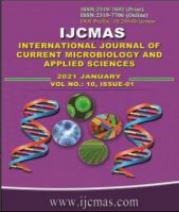


 National Academy of Agricultural Sciences (NAAS)
National Academy of Agricultural Sciences (NAAS)

|
PRINT ISSN : 2319-7692
Online ISSN : 2319-7706 Issues : 12 per year Publisher : Excellent Publishers Email : editorijcmas@gmail.com / submit@ijcmas.com Editor-in-chief: Dr.M.Prakash Index Copernicus ICV 2018: 95.39 NAAS RATING 2020: 5.38 |
A field experiment was conducted 2015-16 and 2016-2017 at experiment farm Soil Conservation of Water Management in C.S. Azad University of Agriculture and Technology, Kanpur. The experiment was carried out in factorial complete randomized block design with three replications and three nutrient management i.e. N1 (100% RDN), N2 (75% RDN through chemical fertilizers + 25% RDN through vermicompost) and N3 (75% RDN through chemical fertilizers + 25% RDN through vermicompost + Azotobactor) and two varieties i.e. V1-Narmada (K- 603), V2-Azad (K-125) and three level of moisture conservation practices i.e. M1 -Control, M2 -Dust mulch created by weeding and hoeing followed by hand hoe after 25 days of sowing, M3-Herbicide (2,4-D, 35 days after sowing). Results revealed that 75% RDN through chemical fertilizer + 25% RDN through vermicompost + Azotobacter, variety Narmada of barley and dust mulching practices of moisture conservation practices produced significantly more growth parameters, root studies and water use efficiency than the other treatments during both the years of study. The farming majority may be advocated for adoption of 75% RDN through chemical fertilizer + 25% RDN through vermicompost + Azotobacter, variety Narmada of barley and dust mulching practices of moisture conservation practices for good productivity and profitability under rainfed farming.
 |
 |
 |
 |
 |